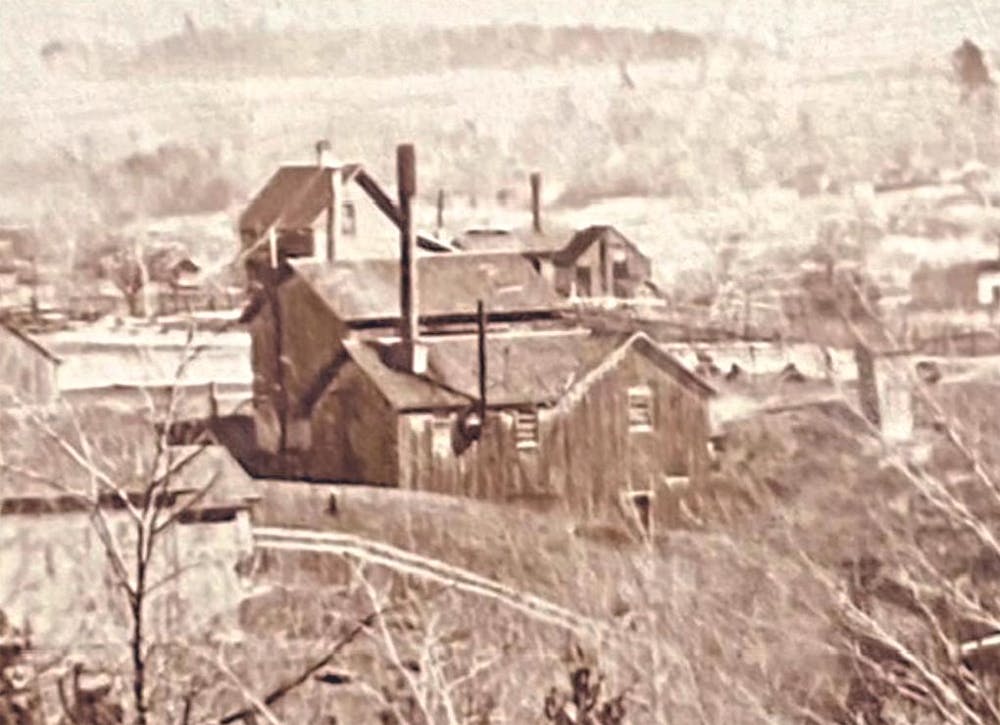On Wednesday, Dec. 21, 1877, a group of men from Montague pooled their resources and formed a “Partnership Association Limited” for the purpose of “drying/preserving fruit, and the manufacture of cider, jelly and vinegar” and named it the Montague Fruit Preserving Company. The list of stockholders was as follows:
Burrows & Jones (Frank E. Jones/Charles E. Burrows), George H. Mason, George Klett, Thomas E. Phelan, George R. Hancock, Lafayette G. Ripley, William H. Lobdell, Stephen D. Shattuck, Robert Deymann, Gerhard Luehrs, William A. Rowe, John S. McCoughey, John F. Herren, Austin & Warnick (Warren A. Austin/Henry Warnick), and Peck & Gaynor (William Peck/Thomas Gaynor).
The managers of this partnership consisted of Frank E. Jones (Chairman), Warren A. Austin (Secretary), Lafayette G. Ripley (Treasurer), Thomas Phelan, and Stephen Shattuck. It was understood by the stockholders that the extent and duration of the partnership was 20 years from the date of creation.
Burrows and Jones provided the property for the construction of the cider mill as part of their investment into the partnership. This two-acre property was primarily located on the north side of Buttermilk Creek in the Northwest quarter of the Southeast quarter of Section 20, Montague Township.
The cider mill was constructed on a plateau created partway down the bank to the creek. A dam was built on the creek, creating an impoundment that provided a water source for the steam engine that powered the mill.
The cider mill was in operation for only a couple of years before it was given a complete overhaul. New machinery was installed, including an evaporator, and the water pump and water storage tank were rearranged for more efficient use. This overhaul allowed a greater amount of work to be accomplished. Cider and evaporated apples were the main products, but apple butter, jelly, syrup, wine and boiled cider were also produced. Custom work, such as grinding stock feed, was also available to customers.
Sometime during the year 1894 John Rutledge, a carpenter by trade, acquired majority ownership in the company and served as manager, continuing the production of cider, vinegar, apple butter, etc. The mill operated for several years under Mr. Rutledge, and in 1902 a couple of businessmen from Chicago by the names of Prager and Darlington visited the mill with an interest in purchasing it. They were pleased with the mill but not its location, claiming that they would acquire the mill if a site could be procured near the lake. The businessmen proposed to add a canning facility to the cider mill factory if adequate property was found. The Montague Board of Trade met and passed a resolution that offered to the businessmen lakefront property that had been acquired by the village in condemnation proceedings. The board was hopeful, but the proposal did not materialize.
Isaac L. Lanford joined Mr. Rutledge as a partner in 1903, and together they bought out the remaining half interest in the company held by William Lobdell. Rutledge and Lanford operated the cider mill until September 1907, whereupon they sold the mill to E. L. Prussing for $1,500. Mr. Prussing was the president of the Western Cider and Vinegar Company located in Chicago, Illinois. He had a branch factory in Indiana and now had a branch in Montague. Walter Prussing, who was the vice president of the company at the time of purchase, as well as the son of E. L. Prussing, assumed management of the mill.
Walter Prussing hit the ground running, grinding up all the available apples in the area and receiving shipments from other areas, such as Brunswick and Rothbury. Apple providers received 40 cents per 100 pounds of apples if delivered to the cider mill. A successful season wrapped up in January 1908 and the cider mill was closed with plans for extensive improvements and alternations.
In August 1908 the cider mill received the planned improvements and was ready for the upcoming apple season. A new press and hydraulic pump were installed along with several huge storage tanks that kept the cider free from exposure, improving the cleanliness of the product. Cider vinegar and boiled cider were the leading products, and the improvements allowed the mill to produce 2,000 gallons a day.
Many farmers in the area were probably pleased to have a market for their lower quality apples but may have been disappointed when they learned that they would only receive 25-32 cents per 100 pounds of apples during the 1908 season.
Walter Prussing continued operation of the cider mill, and in 1910 his company branched into the business of canning pork and beans. Establishing a canning factory in Chicago proved to be very successful, and in March 1911 he proposed to establish a factory in Montague and move the cider mill from the North Hill if a free site and building were provided. Similar to previous efforts to establish a canning factory, this proposal did not materialize, and the cider mill was never put back into operation again.
On Aug. 22, 1913, an electrical storm moved through the Montague area and the cider mill caught fire. When discovered, it was completely engulfed in flames and beyond salvation. Walter Prussing & Co. still owned the mill, and it was reported by one newspaper that the building was not insured, while another paper reported that the mill had not been occupied for a number of years, and that the loss was estimated at $2,000 but fully insured. The cause of the fire was unknown. Some speculated that it was struck by lightning while others were suspicious of an incendiary device. Regardless of the cause, the cider mill had a productive 25-year life span and went out in a blaze of glory.












